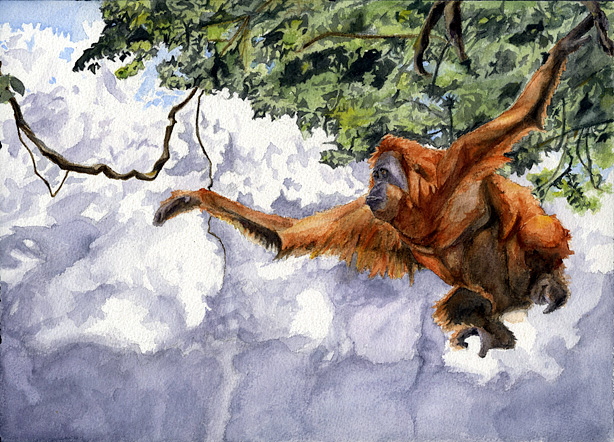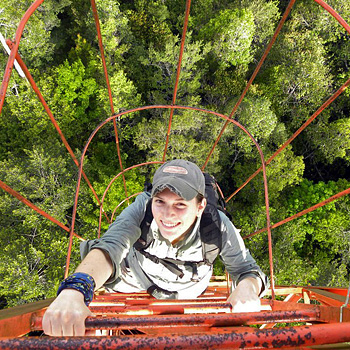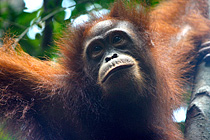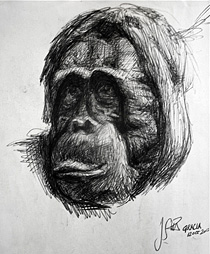
"Orangutangled: Monkeying Around On High," a 2011 watercolor by Jessica Stitt '10 of a Bornean orangutan (pongo pygmaeus) in the forest in Borneo. Image: Jess Stitt/OuTrop 2012.
Alumna wades through Borneo for orangutans
Jessica Stitt '10 has been helping conserve orangutans by capturing them -- in photographs and on paper.

Jessica Stitt '10 climbs into the canopy of the Sabangau Forest in Borneo. Photo: Cassie Freund/OuTrop 2012.
The natural resources graduate used her artistic talents to bolster her scientific interests as she spent five months trudging through peat swamps and thick underbrush in the dense tropical jungles of Borneo in search of orangutans.
On daily hikes to orangutan nests, she collected field data on male and female orangutans of all ages to better understand their behavior. She noted things like habitat, productivity and disturbances to their daily routines.
Details mattered -- and Stitt's sketches provided a great way to hone in on them. It didn't take long for Stitt to be able to recognize individual orangutans, based on their looks and behavior.
"Art and science are about connections," Stitt says. "With both, you are looking at details and relationships surrounding how the pieces fit together."
Some of her most memorable moments involved orangutan interactions with each other and other species.

Image of Georgia, a female orangutan who, according to Stitt, is a "bold little girl [who] gets bored of hiding all day -- she'll come close and try to push down a tree nearby to get your attention." Photo: Jess Stitt/OuTrop 2012
"I saw an adult female orangutan convince a sun bear to vacate a tree she wished to feed in," Stitt says. "And you never forget seeing a huge flanged male orangutan performing a long call -- this reverberates through you and the forest and can be heard kilometers away."
Her illustrations, photographs and field sketches also vividly capture the richness of the forest and its vibrant tropical colors.
It's a habitat she is keen to protect.
Stitt worked in a protected area near Sabangau Forest, a national park formed in 2004 after scientists and policymakers recognized the area as home to the world's largest orangutan population. It is also home to myriad other species, with flora ranging from timber and rubber trees to pitcher plants, and fauna including leopards, deer and more than 200 species of birds.
"The ground was all peat that was spongy and often underwater," Stitt says. "As you walk, you alternate between stepping in shallow pools of red, tannin-filled water and the drier islands of exposed roots, leaves and fallen trees."

Stitt watches an orangutan in a tree. Photo: Cassie Freund/OuTrop 2012.
The entanglement of the forest underbrush inspired the name of her website, Orangutangled, where she showcases her artwork and documents her experiences.
The data she collected will be used in an ongoing study by The Orangutan Tropical Peatland Project (OuTrop), to understand the complexities of the tropical forests in Borneo and build long-term orangutan conservation efforts.
Though the peat forests where Stitt worked are protected, orangutans still face many conservation challenges, including illegal poaching and logging, and forest fires in their native habitats on the Indonesian islands. There are believed to be fewer than 60,000 orangutans left in the wild.
"Orangutans are primates in diverse environments, and we need to understand the roles they play. They provide an important benefit to the forests," Stitt says.
"Indonesia was a friendly, accepting environment," she adds. "We were there to share knowledge and work together to establish best practices, as this research is still a learning process."

One of Stitt's sketches of an adult female orangutan. Image: Jess Stitt/OuTrop 2012
Stitt currently lives in New York City, where she plans to begin a master's program in conservation biology this fall at Columbia University.
She says her experiences at Cornell informed both her scientific and artistic endeavors. Her undergraduate studies focused on applied conservation ecology, and she had several opportunities to conduct fieldwork, including a summer internship in the Arnot Forest near campus and a semester abroad in Costa Rica.
Her interest in photography stemmed from an outdoor photography class offered by Cornell Outdoor Education.
"The further I move along in life, the more … appreciative I am of Cornell," Stitt says. "I love the environment -- the passion, ambition, friends and campus. It was some of the hardest work in my life, but well worth it."
Alex Koeberle '13 is a writer with the College of Agriculture and Life Sciences.